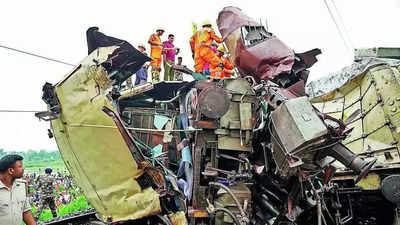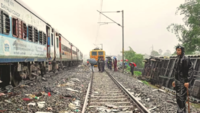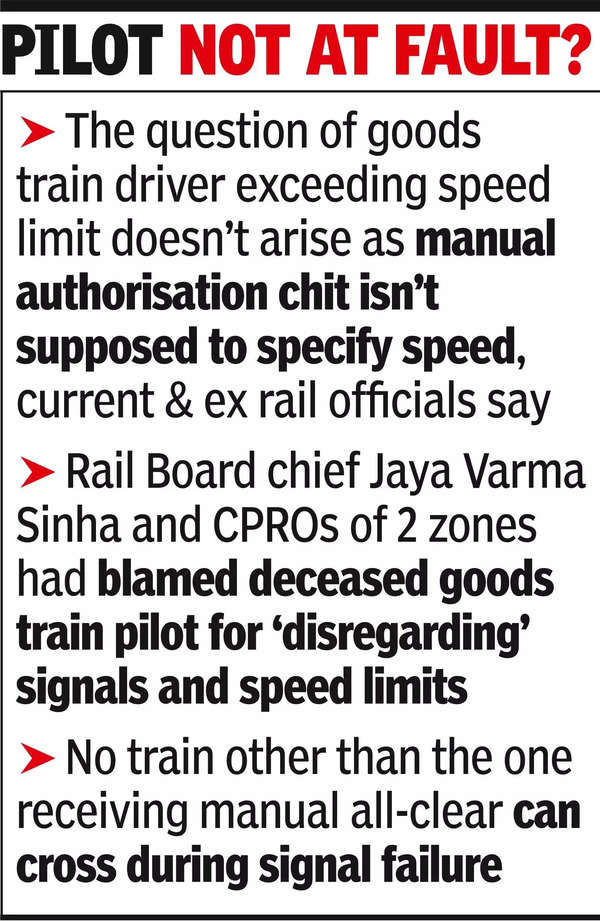- News
- City News
- kolkata News
- Kanchanjunga Express accident: Wrong manual signal to blame for train crash, not dead pilot, say experts
Trending
Kanchanjunga Express accident: Wrong manual signal to blame for train crash, not dead pilot, say experts

KOLKATA: The freight train that ploughed into the rear of the Kanchanjungha Express in north Bengal last Monday should not have been allowed to proceed beyond Rangapani station before the passenger train had crossed Chattar Hat station, based on standard operating procedure for rail traffic cited by several senior serving and retired railway officials.
They pointed out that form T/A 912, a manual authorisation chit or paper line-clear ticket, was "wrongly" issued to the loco pilots of both the freight and express trains in the absence of a functional automatic signalling system. The chit allowed the freight train to pass without reducing speed, leading to the accident that killed 10.
The question of the freight train's loco pilot exceeding the speed limit doesn't arise as T/A 912 isn't supposed to specify speed, the officials said. The authorisation that carries a speed restriction of 25kmph is different - form T/D 912.

Present and former railway officials that TOI spoke to on Wednesday suggested that the root of the problem was possibly the signalling. They also questioned the correctness of the norms being officially cited from the Indian Railways' General & Subsidiary Rules Book (2004 edition). The officials iterated that form T/A 912 isn't supposed to carry any speed restriction as no train other than the one receiving this manual all-clear is authorised to cross a rail section during
"Only when work is under way on the tracks in a particular section is the maximum speed limit mentioned at all on an authorisation note," an official said. "The speed restriction being cited is followed when automated signals are functioning normally and the red signal is on."
When a loco pilot sees a signal with a single yellow light, he has to stop accelerating. If the next signal has two yellow lights, the speed is controlled or reduced. The train is then brought to a complete halt at the red signal.
The train has to wait at the signal for a minute during the day and two minutes at night before proceeding at 10kmph-15kmph, depending on visibility. "When the rear of another train comes into sight, the train has to stop at least 150 metres before," the official said.
This aligns with the SOP mentioned in the G&SR Book and is prominently displayed on a board in the cabin crew lobby at New Jalpaiguri station, near which Monday's crash occurred.
If a signalling failure occurs, the SOP is different. "In that case, a loco pilot can proceed only when a stationmaster issues an authorisation by way of form T/A 912. This paper signal is issued only when there are no trains in the block ahead," said Amit Ghosh, assistant general secretary of the All India Railwaymen Federation.
"When a loco driver gets this form, he can proceed to the end of the block at normal speed. That is precisely what the loco driver of the freight train was doing. He had no knowledge of the presence of the Kanchanjungha Express ahead as the track was supposed to be clear till Chattar Hat station."
The standard practice is for the two stationmasters at either end of a stretch to confirm that there is no train on the section and share a two-three-digit private number, similar to an OTP, which is then noted down in a logbook at both stations. Only then is a fresh authorisation issued to the second train to proceed through the section.
This was corroborated by loco pilots of South Eastern Railway and Eastern Railway. The stationmaster at Rangapani had issued T/A 912 to loco pilots of both trains. The form handed to the Kanchanjungha Express pilot at 8.20am, numbered 4,917, allowed the train to proceed to Chattar Hat, bypassing nine signals mentioned in the note. The note asked the loco pilot to pass all level crossings after ensuring the gates were closed. The Rangapani stationmaster also authorised the freight train to proceed to Chattar Hat (T/A 912, serial No 4,918) at 8.35am, when the express train was barely 2.5km away on the 14km stretch between Rangapani and Chattar Hat.
TOI has copies of both forms. "How did the stationmaster issue the authorisation to the goods train loco pilot without getting clearance from the stationmaster of Chattar Hat? No train is allowed to pass through a block section during signal failure unless another preceding train passes the section," said a former railway official.
Signalling was introduced on the section where the accident took place only seven months ago. The NF Railway edition of the G&SR Book was amended after that (on Nov 10, 2023).
Top Picks For You

'Goods train was doing 40 in 15kmph zone'
They pointed out that form T/A 912, a manual authorisation chit or paper line-clear ticket, was "wrongly" issued to the loco pilots of both the freight and express trains in the absence of a functional automatic signalling system. The chit allowed the freight train to pass without reducing speed, leading to the accident that killed 10.
The question of the freight train's loco pilot exceeding the speed limit doesn't arise as T/A 912 isn't supposed to specify speed, the officials said. The authorisation that carries a speed restriction of 25kmph is different - form T/D 912.

The thesis until Tuesday, based on what Railway Board chairperson and CEO Jaya Varma Sinha and the CPROs of at least two railway zones repeated, was that the deceased loco pilot of the freight train "disregarded" signals and speed limits. The assumption was that the freight train was travelling at almost thrice the speed limit of 15kmph.
Present and former railway officials that TOI spoke to on Wednesday suggested that the root of the problem was possibly the signalling. They also questioned the correctness of the norms being officially cited from the Indian Railways' General & Subsidiary Rules Book (2004 edition). The officials iterated that form T/A 912 isn't supposed to carry any speed restriction as no train other than the one receiving this manual all-clear is authorised to cross a rail section during
signal failure.
"Only when work is under way on the tracks in a particular section is the maximum speed limit mentioned at all on an authorisation note," an official said. "The speed restriction being cited is followed when automated signals are functioning normally and the red signal is on."
When a loco pilot sees a signal with a single yellow light, he has to stop accelerating. If the next signal has two yellow lights, the speed is controlled or reduced. The train is then brought to a complete halt at the red signal.
The train has to wait at the signal for a minute during the day and two minutes at night before proceeding at 10kmph-15kmph, depending on visibility. "When the rear of another train comes into sight, the train has to stop at least 150 metres before," the official said.
This aligns with the SOP mentioned in the G&SR Book and is prominently displayed on a board in the cabin crew lobby at New Jalpaiguri station, near which Monday's crash occurred.
If a signalling failure occurs, the SOP is different. "In that case, a loco pilot can proceed only when a stationmaster issues an authorisation by way of form T/A 912. This paper signal is issued only when there are no trains in the block ahead," said Amit Ghosh, assistant general secretary of the All India Railwaymen Federation.
"When a loco driver gets this form, he can proceed to the end of the block at normal speed. That is precisely what the loco driver of the freight train was doing. He had no knowledge of the presence of the Kanchanjungha Express ahead as the track was supposed to be clear till Chattar Hat station."
The standard practice is for the two stationmasters at either end of a stretch to confirm that there is no train on the section and share a two-three-digit private number, similar to an OTP, which is then noted down in a logbook at both stations. Only then is a fresh authorisation issued to the second train to proceed through the section.
This was corroborated by loco pilots of South Eastern Railway and Eastern Railway. The stationmaster at Rangapani had issued T/A 912 to loco pilots of both trains. The form handed to the Kanchanjungha Express pilot at 8.20am, numbered 4,917, allowed the train to proceed to Chattar Hat, bypassing nine signals mentioned in the note. The note asked the loco pilot to pass all level crossings after ensuring the gates were closed. The Rangapani stationmaster also authorised the freight train to proceed to Chattar Hat (T/A 912, serial No 4,918) at 8.35am, when the express train was barely 2.5km away on the 14km stretch between Rangapani and Chattar Hat.
TOI has copies of both forms. "How did the stationmaster issue the authorisation to the goods train loco pilot without getting clearance from the stationmaster of Chattar Hat? No train is allowed to pass through a block section during signal failure unless another preceding train passes the section," said a former railway official.
Signalling was introduced on the section where the accident took place only seven months ago. The NF Railway edition of the G&SR Book was amended after that (on Nov 10, 2023).
End of Article
FOLLOW US ON SOCIAL MEDIA










